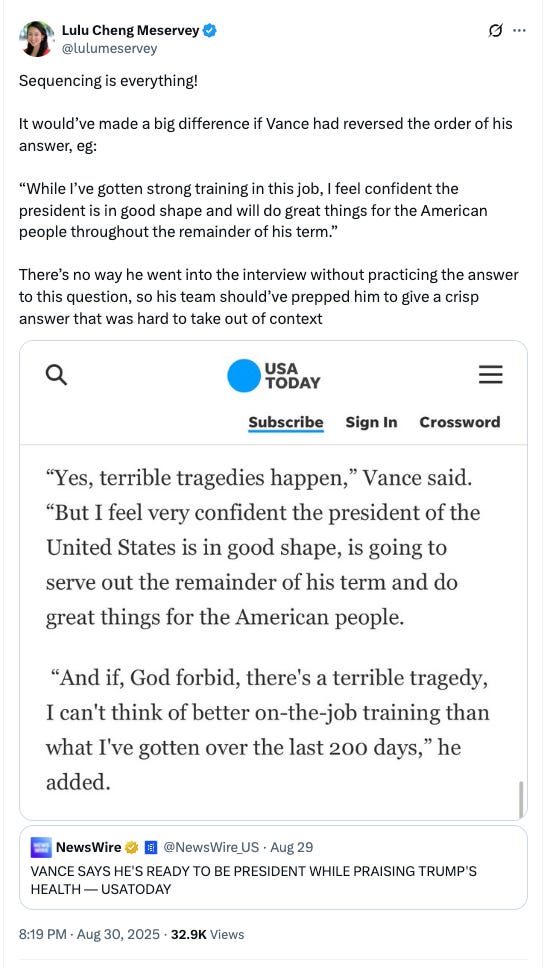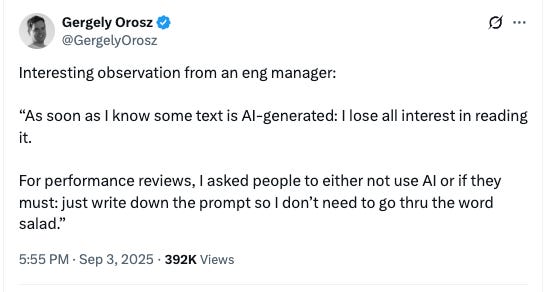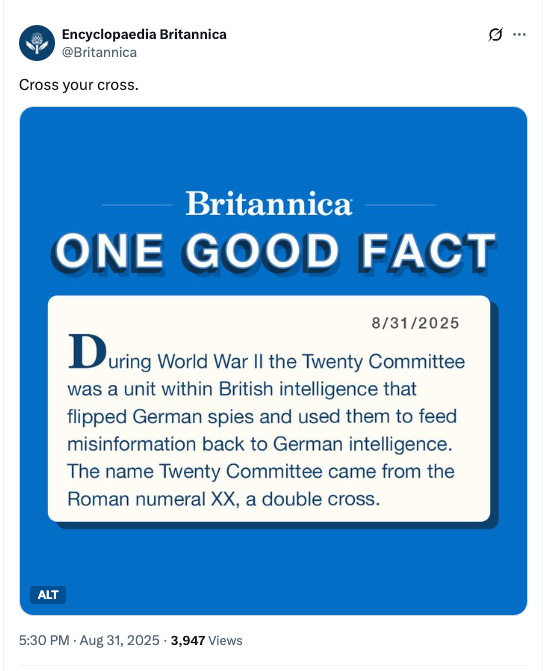An extract from ‘Story Rules’
Gosh, I’ve come to realise that writing the book was the easy part. Promoting it is a massively involved process and I’m feeling super-overwhelmed!
(One side effect – the delay in today’s newsletter… sorry!)
Will share some stories about this experience later!
Thanks for reading The Story Rules Newsletter! Subscribe for free to receive new posts and support my work.
And now, on to the newsletter.
Welcome to the one hundred and thirty-second edition of ‘3-2-1 by Story Rules‘.
A newsletter recommending good examples of storytelling across:
- 3 tweets
- 2 articles, and
- 1 long-form content piece
Let’s dive in.
𝕏 3 Tweets of the week

Interesting point on sequencing!

I too feel the same. You can take ideas from AI. But a complete copy-paste of AI output makes it soulless.

Ooh that’s a great quiz question.
📄 2 Articles of the week
a. ‘TSMP: How Mornings Can Save Your Life’ Derek Thompson
Some useful ideas in this piece, especially for those among us who like to have a drink once in a while.
Here’s Thompson sharing his own struggles with sleep, whenever he had a drink after 8 pm:
Each night that I had a glass of wine after 8pm, my sleep score plummeted. A cocktail after 10pm? I may as well have been hooked up to an IV drip of Brazilian espresso1. But when I had the same glass of red while cooking dinner at 6pm, my sleep was serene and unaffected. I realized I could enjoy both my resveratrol and my REM. The solution was simple. Drink moderately, and drink early.
Thomson elaborates on this idea of having a 3-hour buffer between your last drink and sleep time:
Alcohol is first a sedative and second a sleep disruptor. At a biochemical level, it constricts the brain’s chemical messengers for a few hours, which quiets the mind and makes it easy to zonk out. But, after a while, our chemical messaging functions rebound with a vengeance, causing middle-of-the-night restlessness. For this reason, both MD Anderson and the Cleveland Clinic suggest a three hour buffer between the last drink and bedtime to give our brains and bodies time to clear the rebound effect.
Coming to food now, there’s also scientific evidence that having an early dinner has health benefits:
Several studies have showed that limiting meals to an early time-restricted window improved “insulin sensitivity, glycemic variability, blood pressure, and appetite.”
There are studies which have the same results for taking medicines:
… another 2025 study, which followed 713 patients in France and China with advanced lung cancer, found that those who got drugs before 11:30AM lived more than a year longer than those who received the same treatment after 11:30AM.
There are mixed results on exercise though:
Exercise isn’t like eating and sleeping, because you don’t actually have to do it. Fit people have to make exercise a habit. If your goal is performance, there’s some evidence that later training might be better. But if your goal is habit formation, scheduling the gym earlier in the day makes it more likely that you’ll actually go.
b. ‘From Sunrise to Sunset’ by Sarthak Dev
This is a lovely tribute to cricketer Cheteshwar Pujara, by Sarthak.
I didn’t know these striking stats about the criticality of Pujara’s contributions against Australia:
Pujara scored nearly one-third of his career Test runs against Australia. Across three successive series wins – two on their turf – he was India’s spine. On that epic 2018-19 tour, he accumulated 521 runs, but, amazingly, endured 1258 deliveries, literally and metaphorically grinding the Australian bowlers to dust. No visiting batter has faced more deliveries in a Test series in Australia.
A strong defence is a great skill:
Speaking to Sid Monga about his batting philosophy, Pujara said, “When you defend confidently you know you are in command, you are on top of the bowler, and he doesn’t have a chance to get you out. You will ultimately score runs when he bowls a loose ball.”
Cheteshwar Pujara craves control, wherever he is.
Lovely lines these on how Pujara stuck to his tried and tested method and focused on playing long:
Every series of dot balls was a tiny cut into the bowler’s psyche. Even as the weather around him changed, as Test cricket started to import exotic rhythms, Pujara kept sight of its ultimate batting truth: time is your friend. Five days is a long time, and bowlers are repulsed by serenity.
Another fascinating stat dug up by Sarthak:
Cheteshwar Pujara leaves as a statistical dichotomy. His 7195 Test runs won’t make your eyes pop. He’s 8th on the Indian list, and will be eclipsed by more batters soon. But place the pivot on another column – balls per dismissal – to measure stubbornness. Pujara is third on that list, behind only Rahul Dravid and Sachin Tendulkar.
📄 1 long-form read of the week
a. Extract from ‘Story Rules’ my book on Storytelling techniques for work
I’m sharing a small extract from the first chapter of the book. Hope you enjoy it!
The 8-page document that transformed India’s fortunes
Have you heard the story of the eight-page document that transformed India’s fortunes?
It was the 19th of June 1991. In the heart of New Delhi, a seventy-year-old gentleman was reading an eight-page document, which was opening his eyes.
In mid-1991, India’s economy was in dire straits. The fiscal deficit was out of control and the foreign exchange reserves could cover only two weeks of imports. At the helm of affairs was Prime Minister P.V. Narasimha Rao, a compromise candidate with several detractors. What made things worse was that Rao did not understand economics — he had never held a finance portfolio in his career.
To enhance his knowledge of the Indian economy, Rao was given an eight-page document prepared by senior bureaucrats. The paper spoke about the state of the Indian economy, the root causes driving the current crisis and the remedial steps.
Rao read and re-read the document and by the time he had finished, in the words of his biographer, Vinay Sitapati, ‘the protectionist Rao had given way to the pragmatic Rao’.[i]
Some context: Since Independence, India’s economics had leaned to the left with a distrust of big business and the state assuming an overarching role. Rao was cut from the same socialist cloth. It was perhaps this eight-page document that finally broke the decades-old chains of socialist and protectionist thinking that had enslaved the mind of Rao (and India).
Rao’s first step was to appoint the erudite and mild-mannered economist Manmohan Singh as finance minister. And over the next few months (and years), the prime minister and his band of zealous reformers used a masterful mix of ingenuity, political smarts and courage to prise open India’s economy. India’s 1991 reforms (and subsequent policies) kicked off a new era of unprecedented growth that propelled a seven-fold increase in the per-capita GDP of the country, lifting 250 million Indians out of poverty.[ii]
In short, the 1991 reforms were one of the defining moments of Indian, perhaps global, history.
And a crucial part in this history was played by that eight-page story that was shared at the right time to influence India’s most important leader. That document showed the impact of the right story at the right high-stakes moment.
High-stakes communication moments matter
A packed locker room. About fifteen young women are nervously getting their hockey kits and gear ready for the finals of an international tournament. A man in a starched white shirt strides purposefully into the room and makes his presence known. All girls stand up, facing him. He announces in a commanding voice: ‘Sattar minute. Sattar minute hai tumhaare paas (Seventy minutes. All you have is seventy minutes).’ [iii]
This was an iconic scene from the Hindi movie Chak De India, which chronicled the unlikely victory of the unfancied Indian women’s hockey team in an international tournament. The essence of that speech was this: The next seventy minutes, when you play the hockey finals, will be the most important seventy minutes of your life. So, go out and play your best hockey today . . . so that, whether you win or lose, no one can snatch away the memory of these seventy minutes from you.
To me, this scene is a great metaphor for life. In life, not all moments are created equal. Some moments deserve, nay, demand your highest levels of preparation. One such moment is the ‘High-Stakes Communication Event’ at work. Examples of such moments include:
– A presentation to the board
– A crucial quarterly business review
– A critical client meeting
– A campus pitch to prospective employees
– A fund-raising pitch to investors
The impact of these moments can last for months, if not years—both on you and your organization. However, in many such moments in your life, despite your best preparation, you might have been disappointed with the audience reaction to your presentation:
‘This slide is too busy.’
‘What’s the story here?’
‘This is not engaging.’
‘We’ll get back to you on the pitch.’
Just doing great work is not enough. You also need to tell a great story of your work.
Leaders use storytelling to shine during high-stakes moments
In this book we will see around 300 examples of storytelling techniques used to convince the audience during high-stakes communication events.
Here are some examples of compelling storytelling which feature in this book:
– Steve Jobs’ iconic launch presentations (for the iPod, the iPhone, the MacBook).
– Warren Buffett convincing his shareholders to continue to invest in Berkshire Hathaway through his pithy annual letters.
– Sir Ken Robinson using humour in his viral TED talk.
– Indra Nooyi convincing 400 senior PepsiCo executives about a new flagship initiative.
– Saurabh Mukherjea pitching India to Japanese investors.
– An Indian nonprofit, Kheyti, making a successful fund-raising pitch.
– Greta Thunberg rousing her audience with genuine emotion.
– Bob Iger using trust-building measures to pull off the improbable Disney-Pixar deal.
Through these diverse examples you’ll learn the impact of storytelling techniques, and how humans have been using them to explain, teach, entertain and persuade for millennia.
[i] Sitapati, Vinay. Half – Lion (p. 102). Penguin Random House India Private Limited. Kindle Edition
[ii] Rajagopalan Shruti. The quest for economic freedom in India. Accessed from https://the1991project.com/essays/quest-economic-freedom-india on May 21, 2024
[iii] ‘Sattar Minute Hain Tumhare Paas’. Scene from ‘Chak De India’ by Yash Raj Films. Accessed from YouTube on 26 February 2025. This memorable scene is from the blockbuster movie, ‘Chak de India’, which is based on real-life events and chronicles the inspiring victory of the unfancied Indian women’s hockey team in an international tournament.
That’s all from this week’s edition.
Photo by Diana Polekhina on Unsplash








